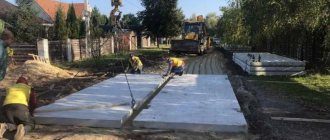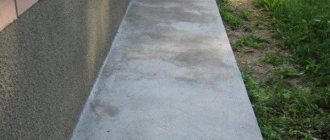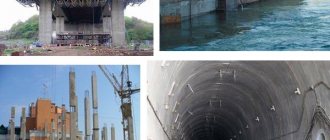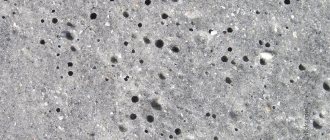The main material used for road construction is asphalt. After a few years, such a coating needs to be repaired, then its operational properties are restored annually. Concrete pavement is much better than asphalt, but its use is limited. There are reasons for this, related to insufficient funding, low productivity levels, climatic conditions, insufficient quantities of cement of the required grades, and relief areas. This technology is not yet particularly popular in Russia, since asphalt roads are much cheaper. However, we note that gradually the cost of these types of canvas is slowly equalizing. The construction of concrete roads, bridges, and runways at airfields begins.
Road surface requirements
The cement-concrete road meets all the requirements of GOST R 50597-2017 and GOST 33151. The main requirements are for the class of concrete and its composition. This will determine how much a concrete road costs.
For road construction in Moscow and the Moscow region, we use heavy concrete with fiberglass and polymer additives, which provides additional wear resistance and strength. In addition, air-entraining additives are introduced to increase frost resistance and the level of chemical resistance.
The main quality criteria for ready-made concrete mortar for road construction are:
- Low level of susceptibility to cracking;
- Resistance to vibration and abrasive effects;
- Chemical resistance: immunity to oils, fuels, reagents that are sprinkled on the road surface to protect against icing;
- Resistant to high compressive and tensile loads;
- Strength and frost resistance.
What is it used for? Kinds
Road concrete is classified as heavy concrete. They are used for laying road surfaces and airfield pavements. It is distinguished by its ability to withstand constant heavy loads. In order to keep costs to a minimum, it is necessary to make concrete as durable as possible.
To produce the correct solution, it is necessary to strictly adhere to the recipe approved by GOST, depending on the place of use.
Road concrete is used for:
- Manufacturing a single-layer plane or a multi-layer top layer. The requirements for such a solution are as high as possible, since concrete will wear out not only from transport, but also from environmental influences.
- Laying the bottom layer of two-layer coatings. Manufacturing of this type is more economical due to lower requirements for its components, as well as the exclusion of the influence of the external environment.
- Filling the base for an improved type. The requirements for such concrete are low.
Impurities are added to the solution, which improve its resistance to low temperatures, the amount and type of which depend on climatic conditions. The components of concrete affect its wear resistance: the more mobile it is, the less stable the roadways will be. The route, in addition to loads from transport, can be influenced by water (snow, rain), temperature changes, so the road concrete for laying it must be of high quality and durable.
Why is it profitable to install concrete highways?
The construction of concrete roads in Moscow and the Moscow region allows you to obtain a road surface with the following advantages:
- high strength: concrete gains strength over time, so the load-bearing capacity of the route will only increase;
- the surface remains slightly rough: drivers do not experience discomfort, but feel that the wheels are more confident and stable on the road, without skidding even in rainy weather;
- specially cut seams allow moisture to be removed in a timely manner and level out thermal expansion;
- the coating does not overheat and does not melt, unlike bitumen-based asphalt;
- concrete is dense and does not generate dust;
- Concrete roads will not need to be replaced for 50 years, and then major repairs will be required;
- construction is carried out in a short time due to the high degree of mechanization of the process.
Compound. Manufacturing Features
Fiber fiber is used in road concrete. For durability and strength, a number of special additives are used that affect the quality characteristics. Polymer admixtures increase the strength of road concrete, including in aggressive environments. Fiber fiber affects resistance to dynamic impact; it provides additional reinforcement. Fiber increases wear resistance and is used for highways.
When preparing the solution, it is necessary to adhere to the proportions of cement, sand and additives (1: 2: 5). In order for road concrete to have all the necessary characteristics, it is necessary to maintain the correct ratio of water and cement in the solution: 0.6 for the lower layers; 0.5 for the top, 0.75 for laying the base. If there is too much water, it can affect the “work” of the additives in the solution.
Diameter of aggregate particles: up to 2 cm in the top layer; up to 4 cm at the bottom. Filler grains affect the solidity of the base; their quantity should not exceed 450 kg/m3, and for the top layer - 500 kg/m3. The mobility of concrete should not exceed 2 cm. Air-entraining additives are used for porosity. This parameter affects frost resistance and tolerance to chemical exposure.
To speed up the hardening of the plane, plasticizers are added during the mixing process. They are added before laying the concrete. Together with air-entraining admixtures and cement, they provide the highest possible properties of concrete.
All additives must be used according to manufacturers' instructions. If several admixtures are used simultaneously, their total amount should be less than 60 g/kg of cement. The solution is adapted in consistency to the installation devices and environmental conditions.
Prices
| Concrete roads | |
| 400mm soil stabilization under concrete pavement | from 500r/sq.m. |
| installation of a 300mm sand base with compaction | from 120r/sq.m. |
| foundation made of crushed stone 100mm with compaction | from 140r/sq.m. |
| construction of concrete roads with a thickness of 150 mm arm. 10mmx150x150 | from 2100r/sq.m. |
The cost is calculated based on the length and width of the section being laid. We draw up an estimate for turnkey construction, that is, we take into account all the costs of materials, operation of heavy equipment, and so on. For very large volumes we provide discounts.
Production
For laying roads, concrete is used, which is produced in factories.
The route is most often filled with solutions that are manufactured at the factory. This production has its own characteristics. The basis of such solutions are plasticizers or hydrophobic Portland cements. The final composition of the mixture depends on the desired result.
For two-layer automobile tracks, the top layer is made of Portland cement (grade M400 and higher), medium-sized and coarse sand, medium-sized crushed stone (compressive strength from 800 kg/m2). For the bottom layer, you can use material with strength from M300.
If the route is laid in conditions where critically low temperatures are possible, additives are used to increase frost resistance. This admixture is selected depending on the average monthly temperature in the area during cold times.
Technology for constructing concrete roads in Moscow and the Moscow region
The stages of constructing a concrete road are as follows:
- Preliminary marking is carried out, according to which the old coating is removed or soil is excavated to a depth of 1 meter.
- An underlying layer of gravel, sand and clay is created with careful layer-by-layer compaction. Layers of bulk materials are spilled with a solution of calcium chloride, which makes it possible to bind residual water and prevent subsidence. The necessary communications, collectors and mortgages for them are installed in the base.
- Asphalt is laid on top of the base cushion in a layer 50-70 mm thick. Two layers are made, one on top of the other. This eliminates soil subsidence, sinkholes and concrete destruction due to the influence of groundwater. In addition, asphalt forms a flexible coating that eliminates transverse cracks and faults. That is, even in the event of subsidence, the road will not crack.
- Fittings with a diameter of 16 mm are mounted. It is placed so that it is slightly above the middle of the screed. This way, there will be enough concrete to protect the steel bars from corrosion, and enough reinforcement to prevent cracking of the concrete. The reinforcement frame is formed in staggered steps, but in such a way that there are more rods in the longitudinal section of the road (that is, in the direction of traffic).
- The prepared mortar is poured over the reinforcement frame and a vibrating rammer is applied. In one pour, a monolithic section of concrete road is formed between thermal joints. The thickness of the screed to be formed is 20-30 cm. The concrete is left to harden for 7 days, and the road is considered fully ready for launch 28 days after the completion of pouring.
Minuses
The main disadvantage is obvious: cement concrete roads are 20–25% more expensive to build than asphalt roads. True, this is only a theory that is not always confirmed by practice. For example, in Tatarstan there is no crushed stone necessary to form a road pie. It has to be delivered all the way from the Urals, and the material becomes more expensive by 50–70%. And if you use local soils with a stabilizer (cement), the construction of concrete can be cheaper.
Or another example. Russia is full of excellent cement - there are 48 factories in different parts of the country. At the same time, there are sometimes interruptions in the production of asphalt in certain regions - there is not enough high-quality domestic bitumen. The missing volumes are purchased... in Venezuela. And here cement concrete will again be more profitable.
On the other hand, the construction of cement concrete roads requires not only high-quality materials. The current human resources and small fleet of equipment cannot be used. Qualified specialists must be trained, and equipment must be purchased, both of which will cost a pretty penny.
In addition, concrete blocks take longer to build. The main reason is technology requirements. It takes 28 days for concrete to gain 70% of its strength. It turns out that if we are not talking about building a new highway, but about repairing an old one, half the road will have to be closed for a month and thereby doom drivers to hours of traffic jams.
Concrete is more sensitive to the effects of deicing agents. Previous technical documentation even prohibited treating the road with reagents for a year after laying so that the concrete could gain strength. But now air-entraining and water-repellent compounds are added to concrete to protect it from corrosion and cracking.
Concrete roads are noisier than asphalt roads, but modern technologies can reduce the difference to a minimum of 2–4 dB. For example, in Germany, a technology is actively used to reduce noise and simultaneously increase the adhesion coefficient of a concrete coating - Waschbeton ("washed concrete"): when laying the top layer, a retarder is used, which then allows the aggregate - crushed stone - to be exposed by a few millimeters.
How long do concrete roads last in Moscow and the Moscow region?
Concrete roads in areas with high loads can be used for 25-40 years without repair and even longer, and from the point of view of drivers, driving comfort does not decrease. And this despite the fact that the average service life of asphalt concrete is 8 years, and then the entire coating needs to be completely replaced. Without taking into account the durability factor, the cost of concrete roads may seem too high, but in practice this is not the case, since the costs of maintenance and repairs during operation are minimal.
The use of reinforced concrete slabs in private construction
Quite often, slabs are used for landscaping garden areas, in individual construction - they are used to make sidewalks, garden paths, entrances to houses and garages. Most often, slabs up to 6 meters long that can withstand loads of up to 10 tons are chosen - these are HDPE 6000x2000x140, 2P60.1.8-10, 2P30.18-10. To make the coating durable, the base is prepared with a layer of drainage and a geotextile covering, which helps prevent the growth of grass in the seams in the area, and then compacted with sand.
For pedestrian paths, trapezoidal, hexagonal, rectangular products of small size and strength are chosen. The base is covered with geotextile and compacted with a sand cushion. It is better to chop or cut the slabs to the required dimensions across or along the reinforcement, at a distance of at least 25 centimeters from the edge. The hinge grooves are filled with fine-grained concrete, the seams - with liquid mortar.
The use of concrete road slabs is justified and beneficial both in large-scale construction and in the development of adjacent areas. Thanks to its excellent performance characteristics, easy and quick installation, low cost and ease of use, this material is relevant for making a wide variety of types of fabrics and elements.
The difference between asphalt and concrete
The fragility of asphalt compared to concrete is due to the following features:
- Asphalt is produced on the basis of sand, crushed stone and mineral additives, and bitumen polymers are used as a binding component.
- The production of concrete involves the use of a sand-gravel mixture, which consists of cement and additives.
The main difference between the two coatings is the type of binder elements in the composition. Unlike a cement mixture, bitumen raw materials do not provide a monolithic connection and can sag under the influence of heavy loads or soil subsidence. Concrete has no such disadvantages.











